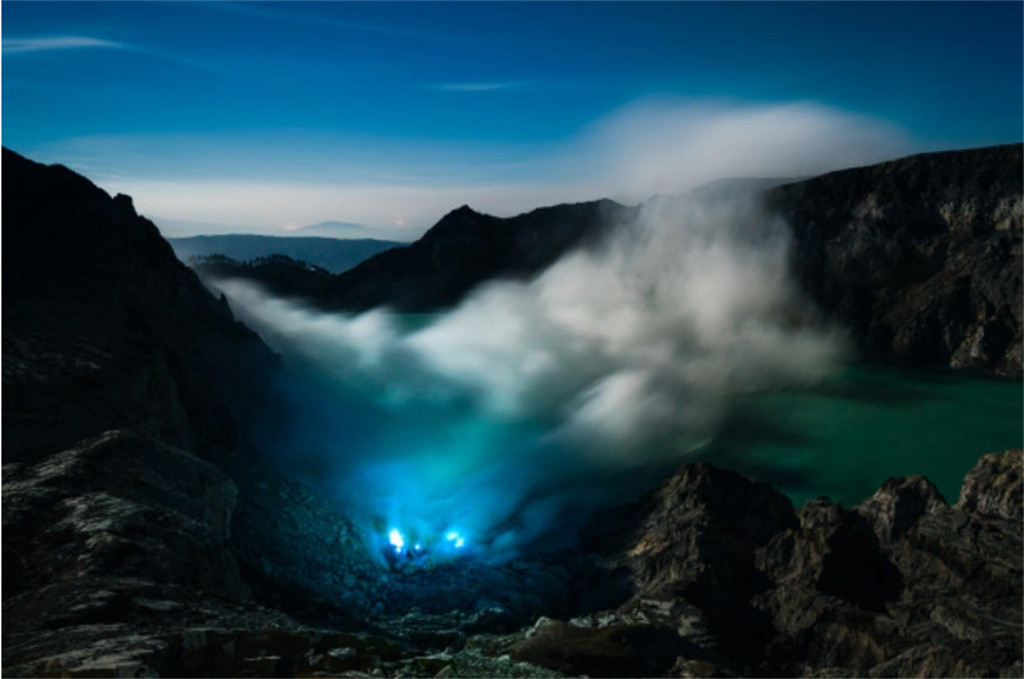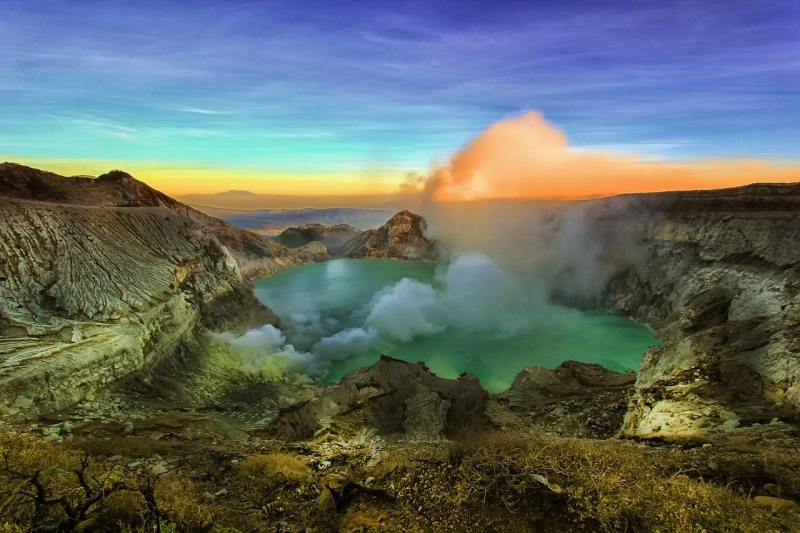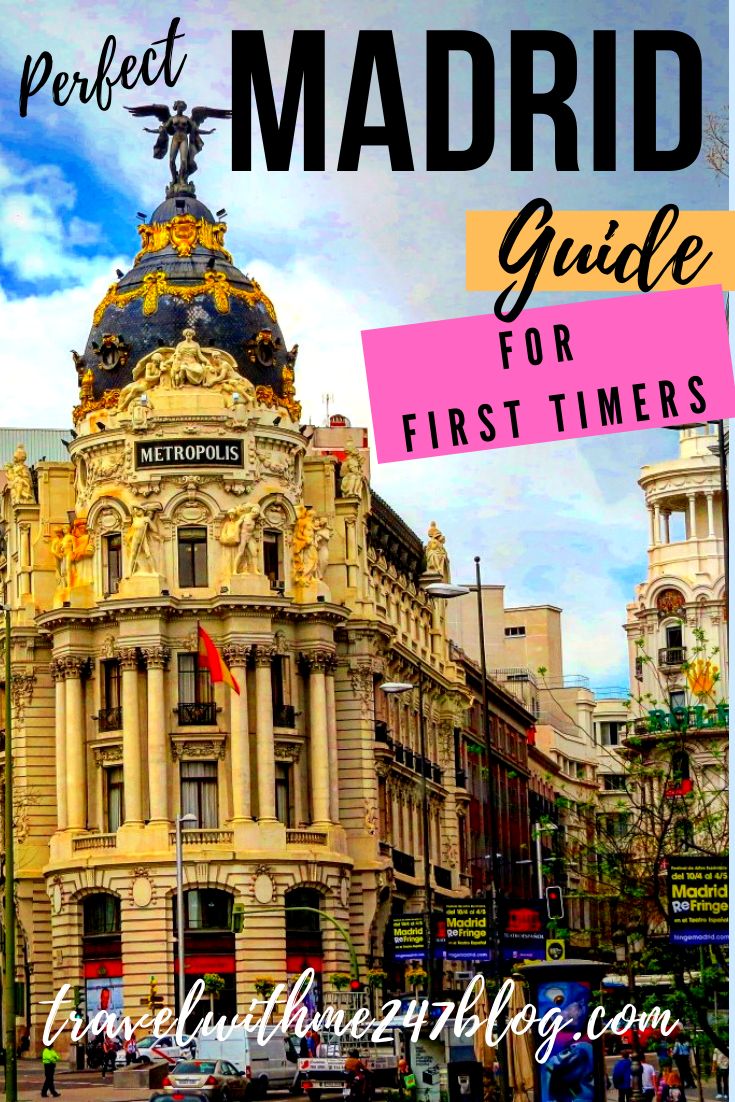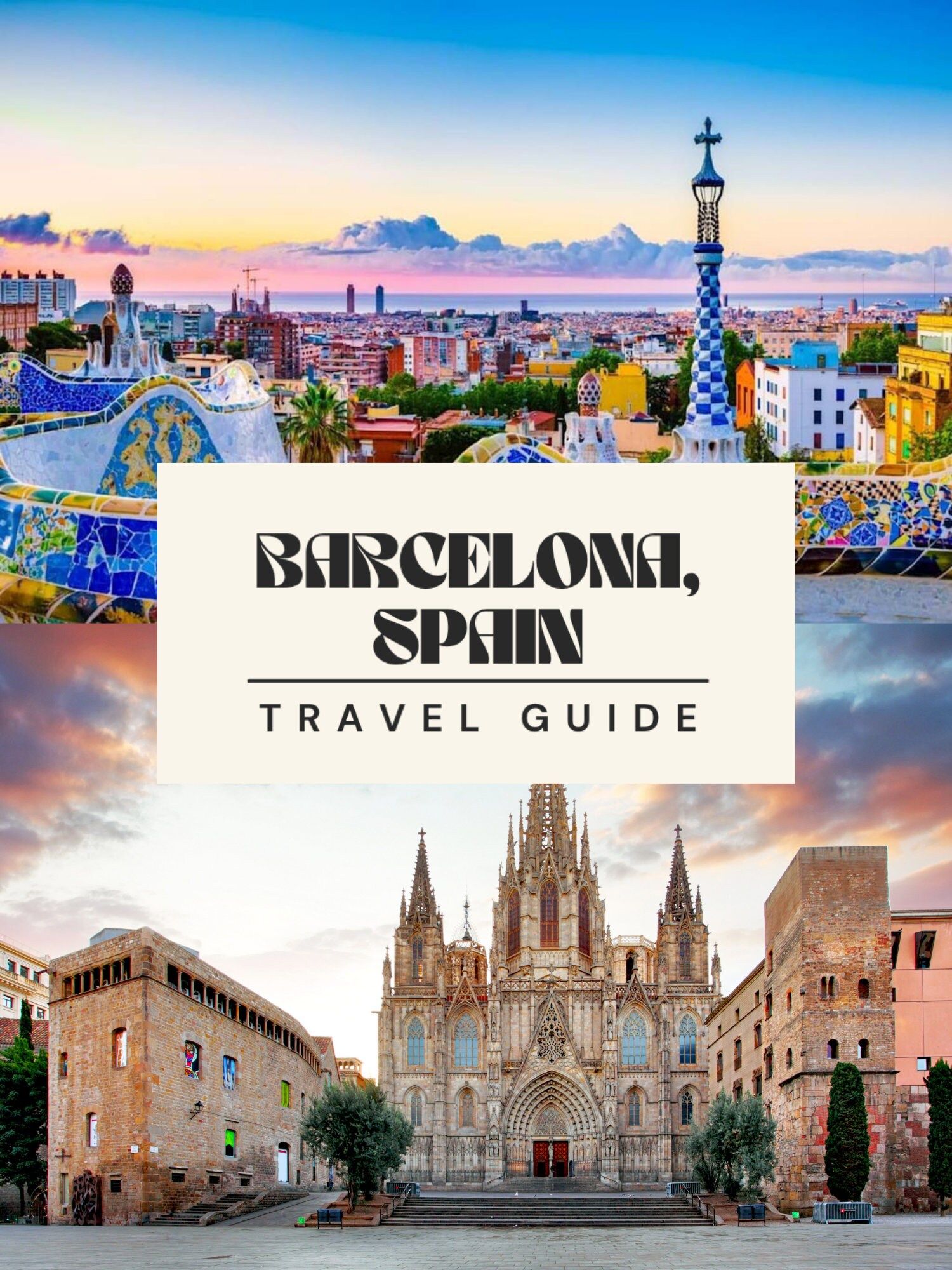
Nestled in the heart of East Java, Indonesia, Mount Ijen stands as a testament to nature’s raw power and ethereal beauty. It’s a destination that transcends the typical volcanic experience, offering a spectacle found almost nowhere else on Earth: the mesmerizing electric-blue flames that dance in its crater under the cloak of night. But Ijen is more than just a geological marvel; it’s a place where the stark realities of human endeavor meet the sublime forces of the planet, creating an unforgettable and often poignant journey for those who venture to its acidic shores.
This comprehensive guide delves into the captivating facts surrounding Mount Ijen, exploring its intriguing history, its breathtaking main attractions, essential travel tips, the best time to visit, nearby accommodation options, local culinary delights, and the various transportation choices available to reach this extraordinary natural wonder.
The Storied Past and Geological Heartbeat of Mount Ijen
Related Articles about Mount Ijen: Unveiling the Blue Fire Volcano:
- Riyadh: A City of Contrasts, Where Tradition Meets Tomorrow
- Shanghai: A Metropolis Where Tradition Meets Tomorrow – Your Ultimate Travel Guide
- Unveiling Paradise: Your Ultimate Guide to the Gili Islands
- Aotearoa Beckons: Unveiling the Top Things to Do in New Zealand
- Patagonia: A Symphony of Ice, Wind, and Wildness – Your Essential Travel Guide
Mount Ijen is not a standalone peak but rather part of the larger Ijen caldera complex, a vast, ancient volcanic structure that stretches across East Java. This complex is home to several stratovolcanoes and volcanic cones, but it is Kawah Ijen, with its iconic crater lake, that draws the world’s attention. The region’s geological history is one of immense tectonic activity, lying on the Pacific Ring of Fire, a horseshoe-shaped belt responsible for 90% of the world’s earthquakes and 75% of its volcanoes.
The Ijen caldera itself formed through massive eruptions tens of thousands of years ago, which caused the ground to collapse into a vast depression. Subsequent volcanic activity within this caldera led to the formation of the current Ijen crater and its surrounding peaks. While the last significant eruptive event from the Kawah Ijen crater itself was a minor phreatic eruption in 1999, the volcano remains highly active, evidenced by its persistent fumaroles, hot springs, and the continuous release of sulfurous gases. This constant geothermal activity is the very engine that drives the unique phenomena observed within its crater today.
Beyond its geological genesis, Mount Ijen’s history is intertwined with human interaction. For centuries, local communities have recognized the mineral wealth contained within the crater, primarily sulfur. The laborious and perilous practice of sulfur mining has been a way of life for generations, a stark economic necessity that contrasts sharply with the awe-inspiring natural beauty surrounding them. This long-standing human presence, adapting to and extracting resources from such a formidable environment, adds a profound layer to Ijen’s narrative, showcasing resilience in the face of nature’s formidable power.
Main Attractions: A Symphony of Fire, Acid, and Human Spirit
Mount Ijen offers a series of unparalleled attractions, each contributing to an experience that is both visually stunning and emotionally resonant.
The Enigmatic Blue Fire
Undoubtedly, the most famous and sought-after spectacle at Mount Ijen is its mesmerizing "blue fire." This isn’t lava, but rather the ignition of sulfuric gases. As highly pressurized, hot sulfuric gases emerge from cracks within the volcano at temperatures exceeding 360°C (680°F), they ignite upon contact with the oxygen-rich air. The intense heat and high concentration of sulfur produce a vibrant, electric-blue flame that can reach heights of up to five meters.
This phenomenon is best observed in the darkest hours before dawn, typically between 2 AM and 4 AM. Tourists begin their ascent in the middle of the night to witness this surreal display, descending into the crater (a challenging and often precarious endeavor) to get an up-close view of the flickering azure flames against the pitch-black backdrop. It’s an otherworldly sight, often described as something out of a science fiction movie, making Ijen truly unique among the world’s active volcanoes.
Kawah Ijen: The World’s Largest Acidic Lake
Perched within the crater, Kawah Ijen (meaning "Ijen Crater") is home to the world’s largest highly acidic crater lake. Shimmering with an intense turquoise hue, the lake is deceptively beautiful. Its striking color is due to the high concentration of sulfuric and hydrochloric acids, making it incredibly corrosive with a pH level often below 0.5. The lake measures approximately 1 kilometer (0.6 miles) wide and 200 meters (660 feet) deep, holding an astonishing 36 million cubic meters of acidic water.
While its beauty is undeniable, visitors are strictly warned against touching the water or even getting too close, as prolonged exposure to the acidic fumes can be harmful. The lake serves as a stark reminder of the volcano’s potent chemistry and the extreme conditions that give rise to its wonders.
The Majestic Sunrise View
For those who brave the nocturnal trek, the reward extends beyond the blue fire. As dawn breaks, revealing the surrounding peaks and the sprawling landscape of East Java, the sunrise view from the crater rim is nothing short of spectacular. The rising sun paints the sky in hues of orange, pink, and purple, gradually illuminating the turquoise lake below and the rugged terrain. The sight of the sun’s first rays hitting the acidic lake, making it glow with an ethereal light, is a powerful moment of natural beauty, providing a serene contrast to the fiery blue spectacle of the night.
The Indomitable Sulfur Miners
Perhaps the most profoundly moving aspect of a visit to Ijen is the encounter with its sulfur miners. These resilient individuals undertake one of the world’s most dangerous and arduous professions. Daily, they descend into the crater, often without adequate protective gear, to chip away at solidified sulfur deposits using simple iron bars. They then load baskets with up to 70-90 kilograms (150-200 pounds) of sulfur and carry it on their shoulders up the steep crater wall and down the mountain for several kilometers to a weighing station.
The work is back-breaking, poorly paid, and fraught with severe health risks from constant exposure to toxic gases. Observing their daily grind offers a humbling insight into human perseverance and the harsh realities faced by those living on the fringes of the global economy. Many tourists choose to offer small tips or gifts, or purchase small carved sulfur souvenirs, as a gesture of respect and support. It’s a poignant reminder that while Ijen is a tourist destination, it is, first and foremost, a workplace for these courageous men.
Travel Tips for a Safe and Memorable Journey
Visiting Mount Ijen requires careful preparation to ensure both safety and enjoyment.
- Physical Fitness: The trek to the crater rim is moderately challenging, covering about 3 kilometers (1.8 miles) with an elevation gain of around 800 meters (2,600 feet). The path can be steep, rocky, and slippery, especially in the dark. Descending into the crater for the blue fire is even more demanding and requires good balance and agility. A reasonable level of fitness is essential.
- Essential Gear:
- Gas Mask/Respirator: Crucial for protection against the highly toxic sulfur dioxide gases. While guides often provide basic masks, a high-quality respirator with P3 filters offers superior protection.
- Headlamp/Flashlight: Absolutely necessary for the pre-dawn trek in complete darkness.
- Sturdy Trekking Shoes: Good ankle support and grip are vital for the uneven terrain.
- Warm Layers: Temperatures can be chilly at night and early morning (especially at the summit), so dress in layers.
- Rain Gear: A lightweight rain jacket or poncho is advisable, as weather can change quickly.
- Water and Snacks: Stay hydrated and energized during the trek.
- Gloves: Useful for gripping rocks and staying warm.
- Safety Precautions:
- Hire a Local Guide: Highly recommended, especially for first-timers and if you plan to descend into the crater. Guides know the terrain, the safest paths, and can assist in emergencies.
- Stay on Designated Paths: Do not wander off, as the terrain is treacherous.
- Respect the Miners: Be mindful of their work, do not impede their path, and ask permission before taking photos.
- Monitor Gas Levels: If the sulfur fumes become too strong, retreat to higher ground or a less affected area. Listen to your guide.
- Do Not Touch the Lake Water: It is extremely acidic and dangerous.
- Be Aware of Your Surroundings: The crater descent is dark, crowded, and slippery. Watch your footing.
- Respectful Tourism: Remember you are visiting a natural wonder and a working environment. Practice Leave No Trace principles, dispose of waste properly, and respect local customs and the miners’ livelihood.
- Health Considerations: Individuals with respiratory issues, heart conditions, or severe asthma should exercise extreme caution or consult a doctor before visiting, as the sulfur fumes can exacerbate these conditions.
Best Time to Visit Mount Ijen
The timing of your visit can significantly impact your experience at Mount Ijen.
- Dry Season (April to October): This is generally considered the best time to visit. The weather is more stable, with clearer skies, less rain, and therefore better visibility for both the blue fire and the sunrise. The trekking paths are less slippery, making the ascent safer and more enjoyable.
- Wet Season (November to March): While Ijen can still be visited during the wet season, be prepared for heavier rainfall, which can make the trails muddy and slippery. Views might be obscured by fog or clouds, and the blue fire phenomenon could be less visible. However, the wet season often brings fewer crowds, offering a more serene experience for those willing to brave the weather.
- Time of Day: To witness the blue fire, you must start your trek around 1 AM to 2 AM, reaching the crater floor before 4 AM. This allows sufficient time to experience the blue flames before the first rays of dawn begin to diminish their intensity. After the blue fire, you can then ascend to the crater rim for the sunrise.
Weekdays generally see fewer tourists than weekends or public holidays, offering a slightly less crowded experience.
Nearby Hotels and Accommodation Options
The primary gateway city for Mount Ijen is Banyuwangi, a vibrant port city on Java’s easternmost tip. It offers a wide range of accommodation options to suit various budgets and preferences.
- Banyuwangi City:
- Luxury/Mid-Range: Hotels like the Ketapang Indah Hotel, Aston Banyuwangi Hotel & Conference Center, or Hotel Santika Banyuwangi offer comfortable rooms, amenities like swimming pools, and often provide tour services to Ijen. They are a good choice for those seeking comfort after a challenging trek.
- Budget/Guesthouses: Numerous guesthouses and homestays provide clean, basic accommodation at affordable prices. Many cater specifically to Ijen trekkers and can arrange transportation and guides. Examples include Jiwa Jawa Ijen, Didu’s Homestay, or various options available on booking platforms.
- Closer to Ijen (Sempol/Licin Area): For those who prefer to minimize travel time on the morning of the trek, there are a few more rustic accommodation options closer to the Paltuding base camp.
- Catimor Homestay and Arabica Homestay are popular choices. These are former coffee plantation guesthouses, offering basic but clean rooms, often with hot water. They are usually booked as part of a package tour. Staying here means a shorter drive to Paltuding, allowing for a slightly later start.
When choosing accommodation, consider its proximity to Banyuwangi train station or airport if you’re arriving by public transport, and whether they offer reliable tour packages to Ijen.
Local Food and Culinary Delights in Banyuwangi
Banyuwangi, as a bustling coastal city, offers a delightful array of East Javanese cuisine, often with unique local twists. After a strenuous trek, you’ll undoubtedly appreciate the hearty and flavorful dishes.
- Nasi Tempong: This is Banyuwangi’s signature dish. "Tempong" literally means "slap" in Javanese, referring to the spicy kick of the sambal (chili paste) that accompanies the meal. It typically consists of steamed rice served with various side dishes like fried chicken, fried fish, tempeh, tofu, fresh vegetables, and, of course, a generous dollop of fiery sambal.
- Rujak Soto: A truly unique Banyuwangi specialty, Rujak Soto is an unusual but delicious fusion of rujak (fruit and vegetable salad with peanut sauce) and soto (traditional Indonesian soup, often beef or chicken based). The sweet, spicy, and tangy rujak is combined with the savory, aromatic soto broth, creating an explosion of flavors that is surprisingly harmonious.
- Pecel Pitik: A flavorful chicken salad where shredded grilled chicken is mixed with coconut milk, spices, and a hint of kaffir lime. It’s often served with steamed rice.
- Sego Cawuk: Another local breakfast staple, consisting of rice served with various side dishes such as shredded fish, corn fritters, and a spicy coconut milk sauce.
- Fresh Seafood: Given Banyuwangi’s coastal location, fresh seafood is abundant and highly recommended. Look for grilled fish (ikan bakar) or various shrimp and squid preparations.
- Ijen Coffee: The Ijen region is renowned for its high-quality Arabica and Robusta coffee plantations. Don’t miss the opportunity to try a cup of locally grown coffee, often found in cafes and homestays around Banyuwangi and closer to the Ijen base.
Local markets (pasar) and small eateries (warungs) are the best places to experience authentic local flavors at very affordable prices.
Transportation Options to Mount Ijen
Getting to Mount Ijen involves a multi-step journey, typically starting with reaching Banyuwangi and then arranging transport to the Paltuding base camp.
1. Getting to Banyuwangi (BWX – Blimbingsari Airport):
- By Air: Banyuwangi has its own airport, Blimbingsari Airport (BWX), with direct flights from Jakarta (CGK) and Surabaya (SUB). This is the fastest option for those coming from other major Indonesian cities.
- By Train: Banyuwangi is well-connected by train from major cities in Java, including Surabaya (approximately 6-7 hours) and Yogyakarta (a longer journey, often requiring a change). The train journey offers scenic views of the Javanese landscape. The main station is Karangasem Station or Banyuwangi Kota Station.
- By Bus: Buses connect Banyuwangi to various cities in Java. While it’s the most economical option, it can also be the longest and least comfortable.
- From Bali (by Ferry): Many travelers combine a trip to Bali with Ijen. You can take a bus or taxi from anywhere in Bali to Gilimanuk Port on Bali’s western tip. From Gilimanuk, frequent public ferries cross the Bali Strait to Ketapang Port in Banyuwangi (approximately 45-60 minutes). From Ketapang Port, it’s a short taxi or ojek ride to Banyuwangi city.
2. Getting from Banyuwangi to Paltuding (Ijen Base Camp):
- Organized Tour: This is by far the most popular and recommended option. Most hotels and tour operators in Banyuwangi offer overnight or early morning Ijen tours. These packages typically include round-trip transportation from your hotel, a local guide, gas masks, and sometimes breakfast. This is the most convenient way, as they handle all logistics for the midnight start.
- Rental Car/Motorbike: If you’re comfortable driving in Indonesia, you can rent a car (with or without a driver) or a motorbike in Banyuwangi. The drive to Paltuding takes approximately 1.5 to 2 hours. Be aware that the road can be steep and winding, especially in the dark. A driver is highly recommended if you’re unfamiliar with the roads or driving conditions.
- Ojek (Motorbike Taxi): For a more local experience, you can hire an ojek from Banyuwangi to Paltuding. Negotiate the price beforehand, and ensure they are willing to wait for you until you finish the trek and drive you back. This is generally suitable for solo travelers.
Regardless of your chosen mode of transport, it’s crucial to arrange your journey to Paltuding well in advance, especially during peak season, to ensure a smooth and timely start to your Ijen adventure.
Conclusion
Mount Ijen is more than just a volcanic peak; it’s a realm where nature’s most spectacular and perilous elements converge. From the ethereal blue flames that dance in the darkness to the world’s largest acidic lake shimmering in turquoise, and the incredible human story of the sulfur miners, Ijen offers a profound and multi-layered experience. It challenges the senses, stirs the soul, and leaves an indelible mark on all who visit.
By understanding its history, respecting its dangers, preparing adequately, and engaging with its local culture, visitors can embark on a journey that is not only visually breathtaking but also deeply moving and truly unforgettable. Mount Ijen stands as a testament to the raw beauty and formidable power of our planet, a place where adventure, natural wonder, and human resilience intertwine to create an extraordinary narrative.








